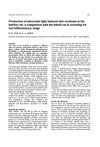Search
for
Sort by
Research
570-600 / 1000+ resultsresearch Ornithine Decarboxylase Expression in Cutaneous Papillomas in SENCAR Mice Is Associated with Altered Expression of Keratins 1 and 10
High ODC and low K1 and K10 may indicate early skin tumors in mice.

research A Frameshift Insertion in SGK3 Leads to Recessive Hairlessness in Scottish Deerhounds: A Candidate Gene for Human Alopecia Conditions
A genetic mutation in the SGK3 gene causes hairlessness in Scottish Deerhounds and may relate to human hair loss.

research The Genomic Variation in Textured Hair: Implications in Developing a Holistic Hair Care Routine
Afro-textured hair needs personalized care due to its unique genetic traits.

research Influence of TRPV3 Mutation on Hair Growth Cycle in Mice
The TRPV3 gene mutation affects hair growth by keeping mice in the growth phase longer, which could help treat hair loss.

research Loss of Epidermal Melanin Unit Integrity in Human Skin During Melanoma Genesis
Melanoma development can be linked to the breakdown of skin's melanin-producing units.

research Male Androgenetic Alopecia
Hair loss in men treated best with early medication or transplant, new treatments researched.

research Hair Follicle Associated Pluripotent Stem Cells Stimulate Hair Growth in Transplanted Mice
Stem cells from whiskers can be transplanted to stimulate hair growth.

research Production of Ultraviolet-Light-Induced Skin Erythema in the Hairless Rat: A Comparison with the Haired Rat in Screening for Anti-Inflammatory Drugs
Hairless rats are good for testing anti-inflammatory drugs, similar to haired rats, without needing to remove fur.

research The Peach RGF/GLV Signalling Peptide pCTG134 Is Involved in a Regulatory Circuit That Sustains Auxin and Ethylene Actions
The peach gene pCTG134 helps control the interaction between auxin and ethylene hormones during fruit ripening.
research Relation of Skin Polyamines to the Hairless Phenotype in Transgenic Mice Overexpressing Spermidine/Spermine N1-Acetyltransferase
Excessive putrescine causes hair loss in transgenic mice by disrupting hair follicle development.

research Experimental Cutaneous Bacillus Anthracis Infections in Hairless HRS/J Mice
Hairless HRS/J mice resist Bacillus anthracis skin infections due to high numbers of immune cells, not because they lack hair follicles.

research Study of Seed Hair Growth in Populus Tomentosa, an Important Character of Female Floral Bud Development
Poplar seed hairs grow from the placenta at the ovary base, with endoreduplication playing a key role in their development, and share similar cellulose synthesis processes with cotton fibers.
research In This Issue
The studies identified key factors and potential treatments for skin and hair disorders.

research Madarosis
Madarosis is the loss of eyelashes and eyebrows due to various health issues and requires thorough examination to diagnose and treat the underlying cause.

research Dermal White Adipose Tissue Development and Metabolism: The Role of Transcription Factor Foxn1
Foxn1 is important for fat development, metabolism, and wound healing in skin.

research miR-29a-5p Inhibits Prenatal Hair Placode Formation Through Targeting EDAR by ceRNA Regulatory Network
miR-29a-5p prevents the formation of early hair structures by targeting a gene important for hair growth and is regulated by a complex network involving lncRNA627.1.

research Male and Female Androgenetic Alopecia
AGA causes permanent hair loss; minoxidil helps men, finasteride helps men, minoxidil somewhat helps women, estrogens/antiandrogens lack evidence for women.

research A Spermidine-Based Nutritional Supplement Prolongs the Anagen Phase of Hair Follicles in Humans: A Randomized, Placebo-Controlled, Double-Blind Study
A spermidine-based supplement may help hair grow longer by keeping it in the growth phase.
research The Acyl-CoA Binding Protein Is Required For Normal Epidermal Barrier Function In Mice
ACBP is crucial for healthy skin in mice.

research Bone Morphogenetic Protein Signaling Regulates Postnatal Hair Follicle Differentiation and Cycling
Blocking BMP signaling causes hair loss and disrupts hair growth cycles.
research The Synergistic Effect of Phototherapy and Active Substances on Hair Growth
Combining light therapy with certain substances improves hair growth in people with hair loss.

research Activation of Transient Receptor Potential Vanilloid-3 Inhibits Human Hair Growth
Activating TRPV3 stops human hair growth.
research Activation of Polyamine Catabolism Profoundly Alters Tissue Polyamine Pools and Affects Hair Growth and Female Fertility in Transgenic Mice Overexpressing Spermidine/Spermine N1-Acetyltransferase
Overexpressing a specific enzyme in mice causes hair loss and female infertility.
research Prevalence of Low Serum Vitamin D Levels in Patients Presenting With Androgenetic Alopecia: A Review
Low vitamin D levels are linked to hair loss, and vitamin D might help treat it.

research The Character 'Hairless' in the Mouse
Hairless mice lack fur due to a genetic mutation affecting skin response, not hormone issues.

research AXR3 and SHY2 Interact to Regulate Root Hair Development
AXR3 and SHY2 genes control the growth and timing of root hair development in plants.

research Efficacy of Subcutaneous Injection of Platelet-Rich Plasma in Alopecia: A Clinical and Histological Pilot Study on a Rat Model with a Six-Month Long-Term Follow-Up Experience
Injecting platelet-rich plasma under the skin significantly improves hair growth and quality without harmful effects.

research Maternal PPARγ Protects Nursing Neonates by Suppressing the Production of Inflammatory Milk
A mother's PPARγ is crucial for preventing harmful milk that can cause inflammation and growth problems in babies.
research Skin Cyst: A Pathological Dead-End With a New Twist of Morphogenetic Potentials in Organoid Cultures
Skin cysts might help advance stem cell treatments to repair skin.